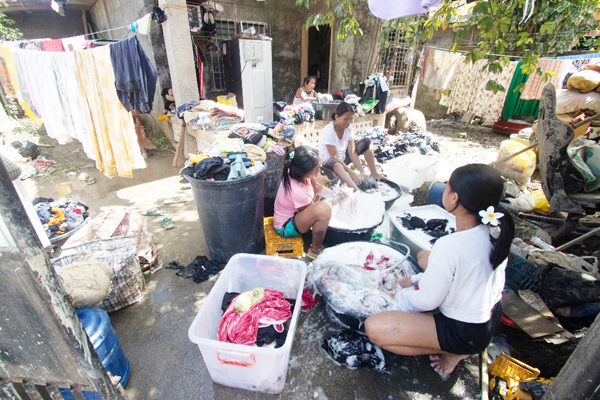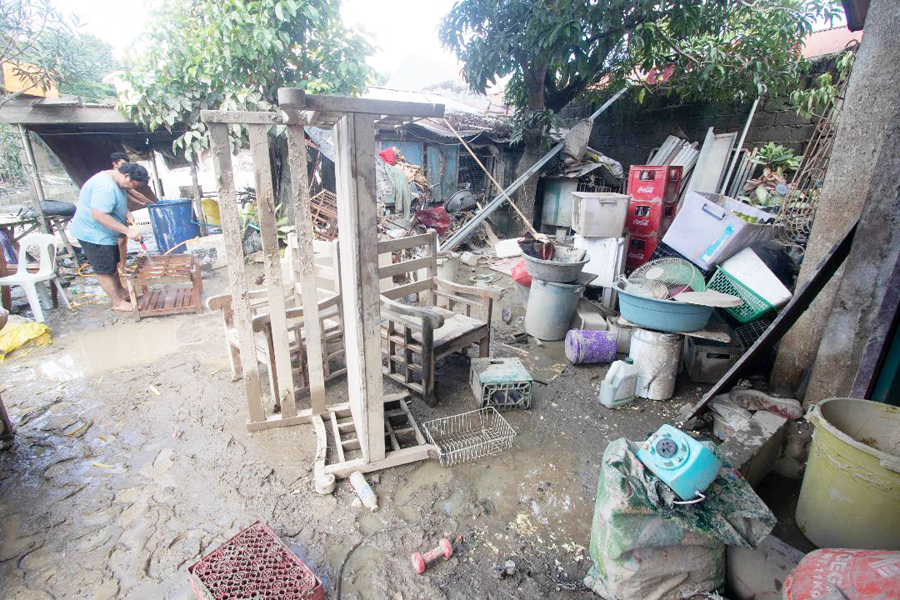DAVAO CITY – Many residents of a subdivision here have mastered the art of evacuation as well as adaptation as they have nowhere to go when flood strikes.

RESIDENTS wash clothes on Monday, February 5, a week after hundreds of houses were submerged by flood at Jade Valley Subdivision in Barangay Tigatto, Davao City. (Keith Bacongco)
Flooding has been a problem for residents of Jade Valley Subdivision in Barangay Tigatto for more than two decades.
The most recent was on January 31 due to continuous rains from the trough of a low-pressure area.
Thus, for many residents, evacuation has been an occasional part of their lives.
One of them is Felix Guma, now in his 50s, who has been living in Jade Valley Subdivision since 1996.
“I’m already used in this situation, I know what to do and what to bring every time we need to evacuate,” Guma said.
He recalled that in the 1990s, the flood water was about knee-deep. But as years went on, flood waters keep on going up, he added.
“In the past, the flood water was just in our knees. Then up to our hips, to our neck, and then all over our heads,” Guma recounted.
He recalled that among the worst flooding that hit the village was in 2011, 2012, and 2013.
But the worst, according to him, was in 2017 when it reached over eight feet and destroyed the ceiling of their house.
Guma disclosed that the flood destroyed many of their home appliances and other belongings.
As a result, they have stopped buying expensive appliances because they know that these might be destroyed again when another flood strikes.
“We used to have an automatic washing machine. But it was destroyed in one of the recent flooding. But our manual washing machine is still working for nine years already despite being submerged many times in the flood.”
Like other residents, Guma said he is planning to build a second floor on his house since they have nowhere to go. “If there’s a free relocation site for us, I’d gladly take it.”
Residents in some areas of the subdivision where flood water would rise to about eight feet have built a second floor on their houses.
One of them is 64-year old Jorge Juarez who has been living in the subdivision for almost 30 years.
Juarez said he was forced to add another floor to his house because the flooding is getting worse. His house sits less than 20 meters away from the banks of Davao River.
Like in the past, Juarez said that flood water submerged hundreds of houses due to the swelling of the river.
Mastering the art of evacuation and adaptation
Residents have mastered the art of evacuation and adaptation even as flooding is just occasional in this residential area.
Melanie Lanipga, who has been living at Jade Valley Subdivision since 2015, said they are constantly monitoring advisories issued by barangay officials and the City Disaster Risk Reduction Management Office.
“When we would hear first siren sound, we would prepare food, blankets, and some clothing in case we need to evacuate,” Lanipga said. “We are used to this life, it seems that have already mastered the evacuation.”

RITCHIE Perdido cleans furnitures on Monday, February 5, almost a week after his house at Jade Valley Subdivision in Barangay Tigatto, Davao City was submerged by flood. (Keith Bacongco)
Last week, the CDRRMO implemented a forced evacuation in all residential areas on the Davao River. Hundreds of residents were rescued by responders when they refused to leave their homes.
Lanipga said many refused to evacuate because they thought that flood water will not rise to chest level. “There was flooding here in mid-January due to the rains brought by the shear line. And it was just about three-foot deep. So some of them thought that it would be just the same and they refused to evacuate.”
While some built second floors in their homes to adapt to the occasional flooding, Ritchie Perdido bought a gasoline-powered power sprayer so he would have something to use in cleaning his house after the flooding.
Perdido admitted that he knew that his house and their belongings will be swallowed by the mud. “This was how I prepared for this flood, I bought this power sprayer,” he said with a chuckle.
Like Perdido, most residents in the area were seen scraping and spraying water to remove mud and other debris from their houses.
Appliances, clothes, furniture, and other belongings were laid outside the mud-swathed houses.
“This is has been our problem here in the aftermath of the flood. It’s very difficult to wash away the mud if you don’t have power sprayer. And it should be gasoline-powered because power is not immediately restored even if the floodwaters has receded,” Perdido said.
Even as he knew that the subdivision is a flood-prone area, former market vendor Joel Caasi took the gamble when he bought his house for P350,000 about seven years ago.
Caasi said they immediately built a small extension on the rooftop in preparation for the flood.
Just few months after buying the house in 2017, flood water submerged hundreds of houses due to the swelling of the Davao River.
In the recent flooding, Caasi said they secured computers and gadgets on the second floor of their house.
“We secured our refrigerators using ropes into the post of our house. Otherwise, these would have been washed away into the streets,” he said.
Like many others, Caasi said he has no other place to go. “We just need to adapt and prepare.”
Poor urban planning
Interfacing Development Interventions for Sustainability Executive Director Mark Peñalver said that flooding in this city could be a result of a poor urban planning.
Peñalver also attributed the worsening flood in urban areas to massive real estate development and land conversions.
The perennial flooding problem at Jade Valley Subdivision is due to the fact that it sits on the old riverbed of the Davao River.
Peñalver urged the government to review its plans and policies in addressing the impacts of climate change.
“We have to consider our environmental history for us to move forward with more sustainable interventions and planning that are responsive to changing climate conditions and people. That is what the government should do. Invest more on nature-based solutions to mitigate disaster risks and avoid projects or investments that contribute to climate change.”